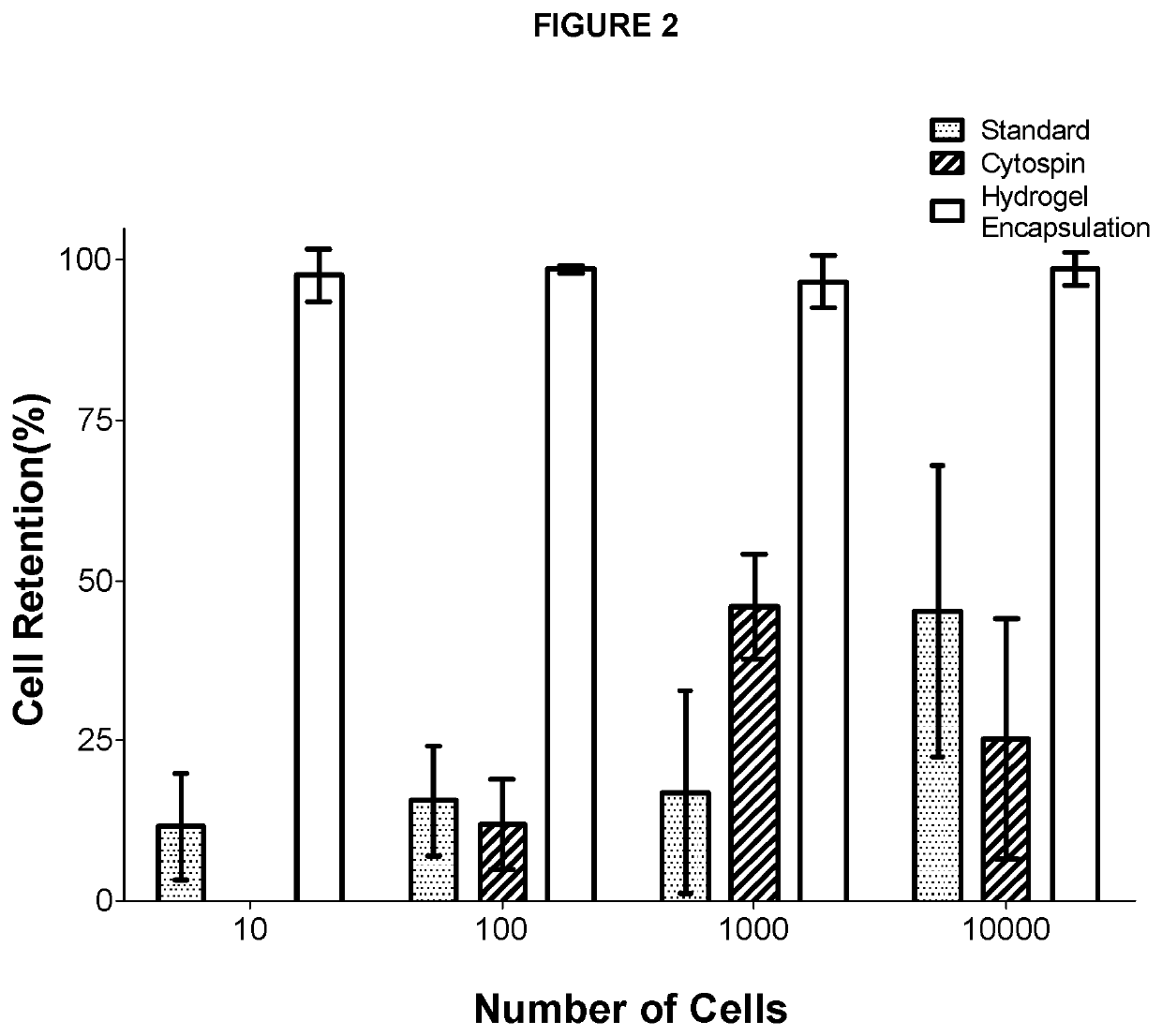Cell encapsulation compositions and methods for immunocytochemistry
a cell encapsulation and composition technology, applied in the field of cell encapsulation compositions and immunocytochemistry, can solve the problems of time-consuming, difficult pelleting, and easy loss of small cell mass during supernatant removal, and achieve the effect of easy attribution
- Summary
- Abstract
- Description
- Claims
- Application Information
AI Technical Summary
Benefits of technology
Problems solved by technology
Method used
Image
Examples
example 1
ion of Hydrogel Cell Encapsulation Compositions
[0090]To prevent damage to the cells and their DNA, a photo-initiator, Irgacure™ 2959, was selected based on its transparency and ability to absorb long wave UV light (>350 nm). To reduce cytotoxicity, the concentration of Irgacure™ 2959 was limited to 0.1% (w / v). However, an alternative cross-linking agent may be used provided and depending on the crosslinking agent chosen may be used at a greater concentration. The thickness, porosity, and mechanical stability of the PEGDA hydrogel can be optimized either by varying their molecular weight or by mixing with poly (ethylene glycol) (PEG) and PBS. The hydrogel porosity can be optimized to encapsulate and affix cells to the surface of an imaging well plate, while allowing antibodies to diffuse through the pores and reach the cells. The mechanical stability of the photo-polymerized hydrogel is important to withstand pipette manipulation during the staining process while the thickness of the...
example 2
and Image Acquisition Using ICC Composition
[0099]To investigate the efficiency of ICC stain as well as image quality of encapsulated cells, we used a standard ICC protocol, according to the manufacturer's guideline40, for staining cells and compared the staining of encapsulated cells to non-encapsulated cells. However, instead of using centrifugation to remove the excess antibody stains, supernatant from each washing step may simply be removed by pipetting. Image acquisition in macroporous hydrogels, after polymerization, has traditionally proven to be difficult due to the large pore sizes29. To determine if the PEG porogen influences image quality, we imaged encapsulated cells before and after photo-polymerization. Prior to polymerization, the hydrogel was transparent, but became lightly opaque after photo-polymerization. However, this color change had no effect on the visualization of unstained or stained cells by bright field microscopy (data not shown). The comparison of PEGDA h...
example 3
ation of Cell Loss in Immunocytochemistry
[0101]To quantify cell loss during ICC, cells were counted before and after ICC for sample sizes of 10, 100, 1,000, and 10,000 cells using three different protocols: 1) traditional ICC performed on 384-well imaging plates, 2) ICC performed on cells adhered to microscope slides using cytospin, and 3) ICC performed on PEGDA hydrogel encapsulated cells. Two individuals counted encapsulated cells in each image and the results were averaged to limit any error resulting from manual counting. Traditional ICC and CytoSpin™ showed a staggering amount of cell loss for cell samples ranging from 10 cells to 10,000 cells (FIG. 2). On the other hand, the current cell encapsulating hydrogel ICC compositions and methods limited cell loss to 1-3% showing improved cell retention during staining, washing, and centrifugation for all sample sizes.
PUM
| Property | Measurement | Unit |
|---|---|---|
| Temperature | aaaaa | aaaaa |
| Length | aaaaa | aaaaa |
| Time | aaaaa | aaaaa |
Abstract
Description
Claims
Application Information
 Login to View More
Login to View More - R&D
- Intellectual Property
- Life Sciences
- Materials
- Tech Scout
- Unparalleled Data Quality
- Higher Quality Content
- 60% Fewer Hallucinations
Browse by: Latest US Patents, China's latest patents, Technical Efficacy Thesaurus, Application Domain, Technology Topic, Popular Technical Reports.
© 2025 PatSnap. All rights reserved.Legal|Privacy policy|Modern Slavery Act Transparency Statement|Sitemap|About US| Contact US: help@patsnap.com



